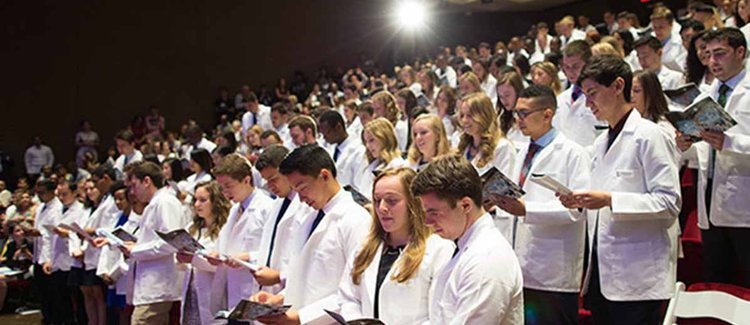From the Editor
It’s been 19 years since I finished medical school. Though almost two decades have passed, medical schools are very similar today – the anatomy lessons, the white coat ceremony, the Hippocratic Oath.
But things appeared different then. No one seemed to have struggled with depression or anxiety. Except, of course, that people did – they struggled quietly, and with shame.
This week’s selection is short and moving, and was just published in JAMA. Dr. Colleen Farrell, a resident of internal medicine at NYU, writes about her depression during her med school days – and the lessons she has learned.
 A white coat ceremony: 1 in 5 adults has a mental health problem – even here
A white coat ceremony: 1 in 5 adults has a mental health problem – even here
This week, we consider Dr. Farrell’s essay.
DG
“Systole and Diastole, Strength and Openness”
Colleen M. Farrell
JAMA, 21 May 2019 Published Online Open Access
https://jamanetwork.com/journals/jama/fullarticle/2733976
‘Seize diastole,’ my medical school professor said. The words were a clever metaphor for a life well lived. During systole, the powerful myocardium contracts, generating pressure that propels open the aortic valve. Blood flows out into the circulation.
Diastole, the process of letting go and filling up, is not as exciting. It could even be taken for granted, cut shorter and shorter. But without adequate time for diastole, there’s no blood to be thrust forward. Homeostasis crumbles. Just as the myocardium needs time to release and refill, so does the soul.
As a second-year medical student, I didn’t give my professor’s advice much thought. But years later, it proved to be a vital lesson.
Toward the end of medical school, I became severely depressed. During my recovery, the question I most needed answered was simply: What happened? How had I gone from an idealistic, enthusiastic medical student to a tearful, hopeless one? To heal, I needed to be able to tell my story. I needed a narrative that made sense to me.
I was familiar with the usual metaphors of depression. It’s a chemical imbalance. It’s just like diabetes. You’re living in a gray cloud. But the usual metaphors of depression didn’t resonate with me. My imagination searched for others, often drawing from the world of medicine.
 Dr. Colleen M. Farrell
Dr. Colleen M. Farrell
So begins a paper by Dr. Farrell which is short, and doesn’t require much of a summary here.
Dr. Farrell writes about a mishap in the OR – a sponge had been left behind, and the surgeon needed to re-open the chest cavity. Ill with depression, she thinks back to the episode:
Many months later, when my depression settled into a heavy, visceral pain in my chest, I thought back to that day in the operating room. Though medically I knew otherwise, I imagined the pain emerging from my heart. I pictured splaying open my chest, so I could inspect it. Maybe I would find a little square sponge that wasn’t supposed to be there. Maybe I could excise the pathology and be healed.
Continuing the cardiac analogy, she notes the importance of diastole.
Though it might sound strange, the physiology of diastolic heart failure helped me make sense of my own story. On the wards as a medical student, I faced a high-pressure system: the long hours, the suppression of my bodily needs, the rigid hierarchy. Attendings asked pimping questions, and I felt like I was constantly being evaluated. I witnessed patients’ suffering and saw death for the first time. I adapted as necessary, like the left ventricle does in the face of high pressure. I got strong and tough. I learned to not cry, and eventually, to not feel… But these changes came at a cost: my heart lost its flexibility.
She recovers from her depression, but leaves with a lesson learned:
[D]iastole is not a passive process. It takes work for the heart to relax. Energy must be expended. It is not enough to simply be away from the inpatient wards for two weeks. To seize diastole, I must continue doing the hard work of processing my fear, frustration, and grief. I must give myself permission to feel and let my heart expand fully. Strength must be paired with openness – and openness is not easy.
A few thoughts:
- This is a beautiful essay.
- It was published in JAMA.
- The hospital parking lot has more pillars than parking spots; today’s cafeteria special isn’t so special; your colleague still hasn’t responded to your last two emails. Life is filled with frustrations, but perspective: it’s never been a better time to be a clinician practicing in mental health.
Reading of the Week. Every week I pick articles and papers from the world of Psychiatry.
Recent Comments